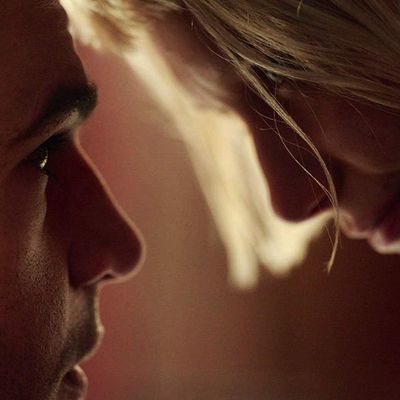
This post contains spoilers for the movie Piercing.
The skeleton of Nicolas Pesce’s new movie Piercing, based on the novel of the same name by Ryū Murakami, is straightforward. A husband and father named Reed (Christopher Abbott) has a compulsion to kill, so he endeavors to exercise this impulse on a prostitute. He tells his wife he has to go out of town on a business trip and sets up at a hotel where the deed will be done. Enter Jackie, a call girl played by Mia Wasikowska. Reed does a walk-through of her murder before she arrives, but the power shifts quickly and his careful planning comes apart when it turns out Jackie has dark desires of her own. We then spend the rest of the movie suspended in a snow globe with Jackie and Reed, wondering which, if either of them, will make it out of the night alive.
Although Piercing defies tidy explanations, Vulture took time to speak with Pesce about his film’s jarring climax. After a spending an entire movie watching Jackie and Reed try to psychologically top each other, their S&M flirtation breaks open. Jackie, a strangely willing participant in Reed’s homicide fantasy up to this point, doses him with a heavy duty benzodiazepine, reducing him to a moaning mass on the floor, drifting in and out of consciousness. She alternately cuddles with Reed and beats him with a heavy weapon while we watch him experience a string of disturbing hallucinations that build out a picture of his most formative traumas. It’s the centerpiece scene of Pesce’s first follow-up to The Eyes of My Mother, his lauded feature debut from 2016, so we asked the director and Abbott to unpack the emotional explosion inside this surreal pocket universe.
A Sense of Place
Piercing exists in a world out of time, and while the structures look familiar enough, they’re also just a little bit wrong and the rules of engagement for the people inside are askew. You’re ready for weird, bad things to start coming out of the walls at any moment, and that’s basically what happens to Reed. In addition to his hallucinatory flashbacks, the room itself turns against him, too. Pesce says he’s always loved Fear and Loathing in Las Vegas, particularly the scene where Johnny Depp is wading through the hotel bar and it transforms beneath his feet. In a movie that plays like a valentine to his influences — the sensuality of a Lucio Fulci film (Pesce calls Piercing his “love letter to giallo”), invocations of the torture scene from Takashi Miike’s Audition, a clean-cut man on the hunt like in American Psycho — you can see the Terry Gilliam come out when the floor starts literally swallowing up Reed.
Jackie’s apartment required especially close art direction, and Pesce designed it with the blocking of the torture scene specifically in mind. “When we’re in the hotel room with Reed, there’s very phallic sculptures all around, but then the second that we go into Jackie’s world, everything is much softer,” says the director, who wanted the set to feel as “crazy and real” to the actors as it did to the audience onscreen. “When you walk in from the get-go it’s already kind of trippy. We have wallpaper with all these lines and these swirls. It’s, like, very vulvic in a Georgia O’Keeffe kind of way.” The music transitions from the Dario Argento favorite Goblin to a schmaltzy love song in “Bluer Than Blue.” The shag carpet needed an especially full pile so the tendrils could wrap around Reed, and the open area where he would fight paralysis needed to be big enough to accommodate his confrontation with Jackie, like a center-stage clearing in a play.
“So much of this sequence is like the unraveling of their kind of game together,” Pesce tells Vulture. “And it’s also like the unraveling of the style of the movie too. It’s super-formalist up until this point, and then you start getting wackier. So it’s very much a turning point stylistically, emotionally, and tonally.”
Getting to Know Reed
As Pesce says, he spent most of his movie “playing with a lot of really dark shit in a kind of fun way.” But when Piercing hits its zenith, we get our first real look at what molded Reed into a repressed would-be killer, thanks to Jackie slipping a drug called Halcion into his soup. It’s an actual powerful sleep aid that occasionally can lead to confusion and “visual disturbances,” and in a state of extreme distress — while also trying to fight the drug’s effects — Reed essentially starts Ambien tripping and has a string of horrific nightmares we can assume are memories: A naked woman who is sexually humiliating him, whom he stabs in the gut. A mother chastising him and threatening to burn his eye with a cigarette. A leather daddy having violent anal sex with a woman, and a little girl in a dominatrix outfit. It’s the closest thing we get to Reed’s origin story, and it’s delivered like a Rorschach test of various abuses. The director wanted to show far more about the character than he told, and keep the exposition within his dream-logic framework.
“So much of the game of it is how little you know about everything, and through this moment we throw so much at you,” says Pesce. “I think a lot of it relies on visceral reactions to very quick images, whether it’s the S&M imagery of the wardrobe or the gore or the emotional violence. It’s really aggressive stuff, and the whole purpose of the sequence is to really give you a glimpse inside of Reed’s mind.” And remember, all this unfolds while Abbott is delivering a whale of a performance on the floor of Jackie’s living room. As a presence, Abbott is an actor who feels like he’s constantly on the edge of a boil, so being trapped in a half-comatose body, forced to emote only through his eyes — with Jackie walloping him every so often about the face — ends up being a wonderfully novel use of his signature intense restraint.
Abbott himself likens it to acting “through a funnel,” forcing a big performance through a tiny outlet, and on a shoot that lasted only 18 days, one of them was entirely devoted to this torture scene. “As kind of fun and funny as it is, it was obviously a bit tiring to have to basically try and throw up and gag,” says Abbott, whose character starts vomiting up the drugs. “It kind of makes you want to actually throw up after a little while. It was physically intense to have to do that over and over.”
Getting to Know Jackie
A unique part of Piercing is that you’re basically watching a two-person play in very static sets where the main characters devote all of their attention to one another, while each one has no idea what the other is thinking. Reed is sure that Jackie is consenting to die, while Jackie sees the whole night as some elaborate murder play without recognizing the endgame of Reed’s fantasy. Pesce likened it to directing them in separate scenes where they happened to share space with each other. Both Abbott and Wasikowska read the whole script as well as the novel, but Jackie and Reed are meant to be using each other as vessels for what they need without interrogating what put them in this situation in the first place.
That all changes in the climax. When Reed briefly comes out of his haze, he starts binding Jackie’s wrists with rope. She giggles and readily opens her mouth so he can insert the gag, but then he tells her explicitly that he’s going to stab her with an ice pick, and she violently protests. Still groggy, he whimpers, “I thought this is what you wanted!” while she screams, and for the first time in the whole movie Jackie and Reed understand each other. Reed begins to lose his drive when it’s clear this murder is not consensual, and we realize that Jackie, who has seemed fully suicidal from the minute she walked onscreen, has just been looking for someone as lonely and wicked as her to play with. She wrestles him off, and he passes out once more.
It’s a strange a-ha moment that manages to feel tender thanks to the weird world that Pesce spent hours building, which comes with its own set of social conventions defined by two equally disturbed people. At this point the audience is judging Reed and Jackie by their value system, not ours, and it’s all held together by the bizarre, believable chemistry between Abbott and Wasikowska. And even though we enter the film from Reed’s point of view, it’s the destabilizing presence of Wasikowska — a trippy sprite who somehow always manages to be both aloof and engaged, whimsical and deadly serious — that creates the tonal palette of Piercing. When the torture gives way to the film’s final shot, it turns out we had been watching Jackie’s romantic fairytale the entire time, a dissonance that invokes Pesce’s troubled heroine searching for connection (also via torture and murder, of course) in Eyes of My Mother.
“As much as like there’s a power struggle on the surface, I think it’s more about like a constant misunderstanding that they’re having with one another,” says Abbott. “It’s a platonic kind of love story, but it’s like finding your soulmate.”





